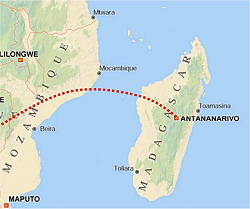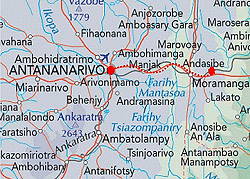|
Trip
to Madagascar - Travel & Antananarivo - April 2004 |
||
|
|
||
 |
Our 2-week
trip to Madagascar started with an uneventful flight from Jo'burg, South Africa to Antananarivo (Tana), the Capitol of Madagascar. As we approached the coast of |
|
|
|
||
| The western lands have rolling hills and are sparsely inhabited. | The population increases inland, since water is more abundant. | As we come to Tana we can see many farms and small villages. |
|
|
||
| Tana is located on a mountain plateau and is at an elevation of about 1200m (4000 ft). | It is a populated area, with half of the country's 16 million people living around here. |
There
are few good streets and those are crowded with old vehicles, people & animals. |
|
|
||
| The people
seem very
religious (mostly Christian). |
They lead
a rather simple life based upon agriculture. |
Sports and
education seem to be given high importance. |
|
|
||
| It was common to see newer vehicles and older animal carts sharing the same road. | The markets were active and we felt very secure walking around (unlike South Africa). | Overall we were pleasantly surprised by how gently the people acted towards us. |
|
|
||
| Monika invited us to a friend's house for a nice Easter brunch. | The pet turtle (not endangered) enjoyed getting tickled by Nicole. | Jay found it weighed more than he thought; the turtle smiled! |
|
|
||
| At the edge of town we could see the fields of rice, the staple crop. | Nicole mentioned that it looked very similar to Vietnam. | Jay thought it looked European, maybe from French influence. |
|
|
||
 |
||
| The next day we headed East towards some National Parks. Note the long Malagasy names. | We hired a driver since rental cars were not an option. As we left town we saw nice valleys. | At the
bottom of each valley was a set of rice fields; using every drop of water they could. |
|
|
||
| The homes here were built quite solidly; mainly with bricks. | There were no fences or gates, so they must feel secure. | Many buildings had shops on the bottom, with living areas on top. |
|
|
||
| Cities along this road did well, as it was the only route from the major port city; lots of trucks! | Pull-carts (called
pousse-pousse) are used as taxis by the locals in this particular town. |
We were surprised to see many imported French sundry items available at these tiny shops. |
|
|
||
| We didn't see any billboards, but there was an ad on this big rock. | Dams
& hydro-power help supply electricity to most people. |
As we dropped in elevation, so did the amount of people. |
|
|
||
| There was little agriculture here, so the incomes were smaller ... | ... and
thus the towns looked much more run down. |
Does anyone want to stay at this hotel? Not us! |
|
|
||
| Surprisingly,
the people didn't pay much attention to us. We were afraid they would
swarm around and beg, but they didn't.
Even in the remote park areas, where the buildings were made from mud & sticks, people acted nicely; too bad the same isn't true in more "civilized" places! |
||
|
|
||
|
|
||
Return up to the Madagascar page |
||
|
|
||